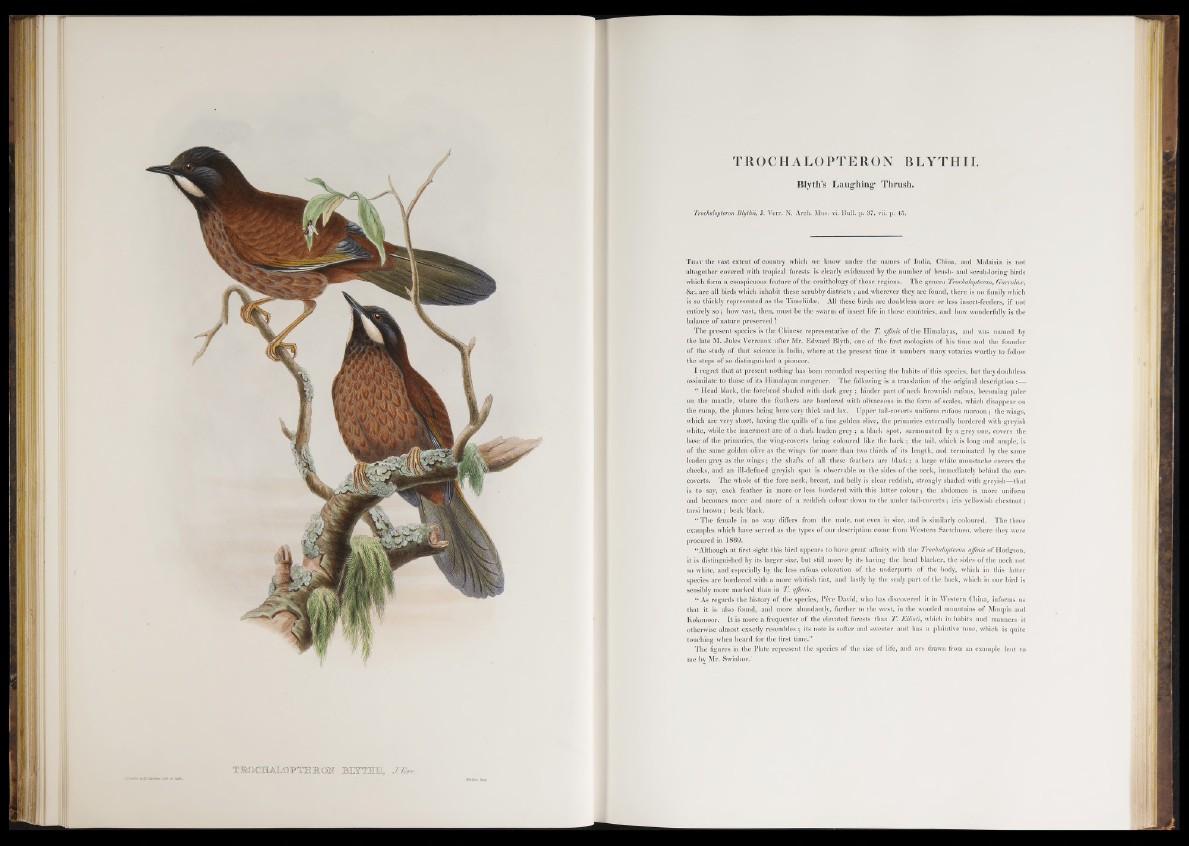
TROCHALOTPTEB.CSN BBTTHU, J.Verr.
TROCHALOPTERON BLYTHII.
Blyth’s Laughing' Thrush.
Trochalopteron Blythii, J. Yerr. N. Arch. Mus. vi. Bull. p. 37, vii. p. 45.
T h a t the vast extent of country which we know .under the names of India, China, and Malaisia is not
altogether covered with tropical forests is clearly evidenced by the number of brush- and scrub-loving birds
which form a conspicuous feature o f the ornithology o f those regions. The genera Trochalopteron, Garrulax,
&c. are all birds which inhabit these scrubby districts; and wherever they are found, there is no family which
is so thickly represented as the Timeliidae. All these birds are doubtless more or less insect-feeders, if not
entirely s o ; how vast, then, must be the swarm of insect life in those countries, and how wonderfully is the
balance of nature preserved!
The present species is the Chinese representative of the T. affinis of the Himalayas, and was named by
the late M. Jules Yerreaux after Mr. Edward Blyth, one of the first zoologists of his time and the founder
o f the study of that science in India, where a t the present time it numbers many votaries worthy to follow
the steps of so distinguished a pioneer.
I regret that at present uothing has been recorded respecting the habits o f this species, but they doubtless
assimilate to those of its Himalayan congener. The following is a translation of the original description :—
“ Head black, the forehead shaded with dark g re y ; hinder p art of neck brownish rufous, becoming paler
on the mantle, where the feathers are bordered with olivaceous in the form o f scales, which disappear on
the rump, the plumes being here very thick and lax. Upper tail-coverts uniform rufous maroon ; the wings,
which are very short, having the quills of a fine golden olive, the primaries externally bordered with greyish
white, while the innermost are of a dark leaden g re y ; a black spot, surmounted by a grey one, covers the
base of the primaries, the wing-coverts being coloured like the back ; the tail, which is long and ample, is
of the same golden olive as the wings for more than two thirds of its length, and terminated by the same
leaden grey as the wings; the shafts of all these feathers are black; a large white moustache covers the
cheeks, and an ill-defined greyish spot is observable on the sides of the neck, immediately behind the ear-
coverts. The whole of the fore neck, breast, and belly is clear reddish, strongly shaded with greyish—that
is to say, each feather is more or less bordered with this latter colour; the abdomen is more uniform
and becomes more and more o f a reddish colour down to the under tail-coverts; iris yellowish chestnut;
tarsi brown; beak black.
“ The female in no way differs from the male, not even in size, and is similarly coloured. The three
examples which have served as the types of our description come from Western Szetchuen, where they were
procured in 1869.
“Although at first sight this bird appears to have great affinity with the Trochalopteron affinis o f Hodgson,
it is distinguished by its larger size, but still more by its having the head blacker, the sides of the neck not
so white, and especially by the less rufous coloration of the underparts of the body, which in this latter
species are bordered with a more whitish tint, and lastly by the scaly part of the back, which in our bird is
sensibly more marked than in T. affinis.
“ As regards the history of the species, Pere David, who has discovered it in Western China, informs us
that it is also found, and more abundantly, further to the west, in the wooded mountains o f Moupin and
Kokonoor. It is more a frequenter of the elevated forests than T. Ellioti, which m habits and manners it
otherwise almost exactly resembles ; its note is softer and sweeter and has a plaintive tone, which is quite
touching when heard for the first time.”
The figures in the Plate represent the species of the size of life, and are drawn from an example lent to
me by Mr. Swinhoe.'